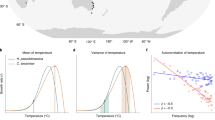Abstract
Theory indicates that correlated weather may synchronize populations1, but the extent to which this holds for non-identical, nonlinear systems is uncertain. Post and Forchhammer2 claim to have shown climate-induced synchrony for musk oxen and caribou that are separated by the Greenland ice sheet. However, logical and mathematical errors undermine their finding. Whether or not large-scale weather can be a major synchronizing factor across species remains an open question.
This is a preview of subscription content, access via your institution
Access options
Subscribe to this journal
Receive 51 print issues and online access
$199.00 per year
only $3.90 per issue
Buy this article
- Purchase on Springer Link
- Instant access to full article PDF
Prices may be subject to local taxes which are calculated during checkout

Similar content being viewed by others
References
Moran, P. A. P. Aust. J. Zool. 1, 291–298 (1953).
Post, E. & Forchhammer, M. C. Nature 420, 168–171 (2002).
Hurrell, J. W. Science 269, 676–679 (1995).
Forchhammer, M. C., Post, E., Stenseth, N. C. & Boertmann, D. M. Population Ecol. 44, 113–120 (2002).
Author information
Authors and Affiliations
Corresponding author
Rights and permissions
About this article
Cite this article
Vik, J., Stenseth, N., Tavecchia, G. et al. Living in synchrony on Greenland coasts?. Nature 427, 697–698 (2004). https://doi.org/10.1038/427697a
Issue Date:
DOI: https://doi.org/10.1038/427697a
This article is cited by
Comments
By submitting a comment you agree to abide by our Terms and Community Guidelines. If you find something abusive or that does not comply with our terms or guidelines please flag it as inappropriate.



